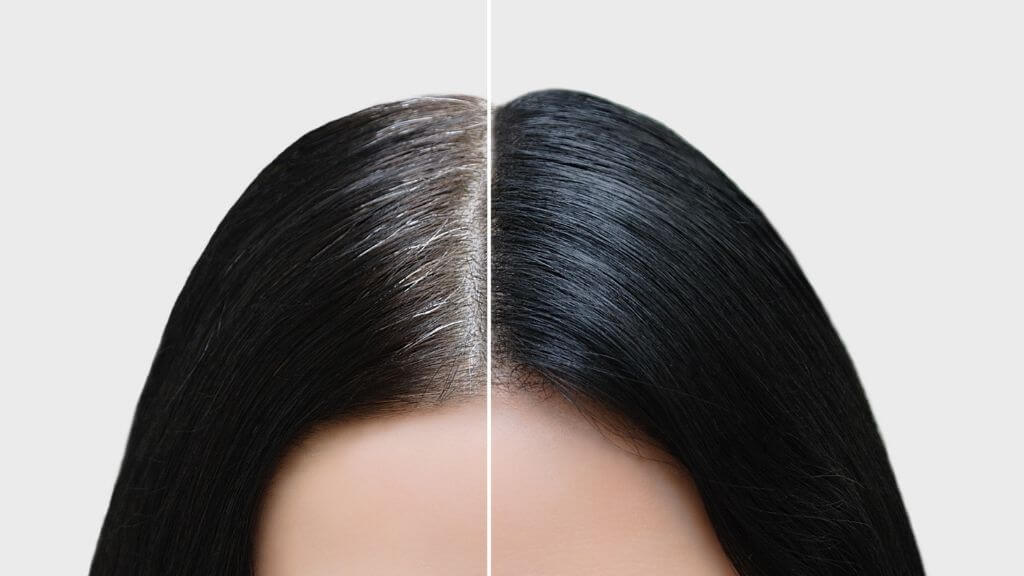Root health basics: Follicle anatomy

If you're looking to grow and strengthen your hair and you’ve followed any of our articles you’ve learned there are no real shortcuts, it’s all about nourishing your hair and treating it properly.
Taking a step back and learning more about your hair will help you understand it and take better care of it. So, let’s dive in and learn more about the anatomy of a hair. It’s actually a fascinating and complex part of the human body.
Each person has about 5 million hair follicles and roughly 100,000 of those are on the scalp. That doesn’t sound like a large percentage, but it is the spot on the body with the greatest density of hair follicles, roughly 300-500 hairs per square centimeter.
The hair follicle is found beneath the top surface of the skin, remarkably it is comprised of 20 different cell types and each one does something specific. Each hair can be broken down into four main parts: bulb, suprabulbar area, isthmus, and the infundibulum.
At the base of each hair follicle is the bulb where the growth begins. In the bulb, the cells divide and form the hair shaft. You’ve probably heard that hair is dead, or not living, and this is true for the majority of your hair, but in the bulb where the cell division is happening, your hair is alive.
The bulb can further be divided into several different portions.
Dermal papilla: This area hosts the hair bulb and provides the vascular connective tissue that gives hair its nutrition. Feeding your hair is important if you want to have long and lush locks. The nutrients you consume get dispersed throughout your body, some landing in the dermal papilla.

Matrix: The matrix of the hair is the growth center, here is where the cell division happens. Beyond this area, all cells in the hair cease to be living.
Hair shaft: The hair shaft begins being formed in the bulb. Obviously, though, it extends out from there, as it’s the hair we see on the outside of our bodies too. Included in the shaft is the very center area, the medulla which is surrounded by the cortex and finally the cuticle.
The suprabulbar area overlaps a little bit with the areas above and below it, but it is where the hair’s protection really begins.
Inner root sheath: Protecting the hair inside the scalp is the inner root sheath cuticle, Huxley’s layer, and Henle’s layer. Huxley and Henle were both scientists who were studying hair follicles and developed theories based upon the areas they discovered.
Outer root sheath: This area is an extension of the epidermal layer of your skin. It protects their hair follicle while also serving as home to many functional areas of the hair including the bulge, the sebaceous gland, and the ancestor pili.
Bulge area: This is a shared area that’s between the suprabulbar and isthmus area. We’ll include it here but remember that it extends into the isthmus.
The bulge is a very special part of the hair and is believed to be where epithelial stem cells are housed. It's difficult to see during some stages of hair growth but is more visible in others.
As mentioned, the isthmus houses part of the bulge, it also is home to part of the arrector pili muscle and the sebaceous gland.
Arrector pili muscle: This is a small band of muscle that connects to the hair follicle. It’s responsible for your hair standing on end or goosebumps. But there is research into the arrector pili that suggests it may be responsible for hair integrity and stability.

Sebaceous gland: You might already be familiar with the sebaceous gland, it’s where that valuable sebum or natural hair oil comes from. This oil lubricates the hair and skin and has some waterproofing capabilities also.
Too much oil can be a problem and cause greasy hair or even build-up that can block the glands. But normal production is healthy and protects your hair, your skin and more.
This area extends from the sebaceous gland to the follicular orifice, or where the hair comes out of the scalp. Because the infundibulum has contact with the outside world, it is quite amazing with its own specialized immune system and immune defenses.
There is still much that is not known about this area, but infundibulum studies are ongoing and there is a lot to learn about how it helps the body battle disease and infections.
Believe it or not, this is a simplification of the human hair follicle, but it does give you a deeper look into what a remarkable part of your body it is.
There’s nothing you can do to get more hair follicles, but you can take care of the ones you have by caring for your hair and feeding it properly. We recommend using natural hair care products that contain no harmful chemicals, fueling your body with ingredients that are hair-friendly and adding a supplement to your diet that supports your hair and the complex system that surrounds it.
If you want to shake up your diet a little, try this Spinach Black Bean Burrito recipe. It gives your hair a boost with the incredible power of black beans bolstered by spinach. In addition, it’s a great meatless dish if you’re looking to cut back on your meat consumption.
At Hair La Vie, we know that your hair is an integral part of how you present yourself to the world and shape your authentic style.
Join our private Facebook Community for a safe, human-moderated space to share your Hair Journey, discover new natural beauty, and take steps towards becoming “you” with the help of an understanding, supportive community.
Join now for instant access to livestreams, discussions, and exclusive access to new products!
Tutorials, education, and helpful tips sent right to your inbox.
JOIN THE GROUP

At Hair La Vie, we know that your hair is an integral part of how you present yourself to the world and shape your authentic style.
Join our private Facebook Community for a safe, human-moderated space to share your Hair Journey, discover new natural beauty, and take steps towards becoming “you” with the help of an understanding, supportive community.
Join now for instant access to livestreams, discussions, and exclusive access to new products!
JOIN THE GROUP